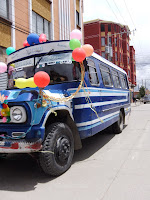 My daily commute involves a variety of transportation -- and today all of it is getting blessed.
My daily commute involves a variety of transportation -- and today all of it is getting blessed.
Most mornings I catch one of the zippy white minibuses that crowd El Alto, while in the evening I make my way home via one of the lumbering microbuses. These decommissioned Blue Bird school busses have been operating in Bolivia for decades – many since the 1950s and 1960s. Sometimes when I’m in a hurry, I make my way down to La Paz in a shared taxi or “trufi” via the switchbacks of Pasankeri. Today I took that route and as the city spread below me it looked like the whole capital was fluttering: it’s carnival and today is Martes de Cha’lla or the Tuesday of libations and blessings; both the capital and its satellite, El Alto, are engulfed in corkscrew paper streamers, pastel plastic flags, loose flower petals, and balloons.
It seems all of La Paz and El Alto are blessing their homes, corners stores, newspapers stands, office buildings, or the neighborhood restaurants they operate out of their adobe homes. I even saw a shoeshine boy walk by this morning with his little kit wrapped in streamers. Although I know to be ready for it, I still can’t help but jump at the startlingly loud firecrackers people set off as they cha’llar their sources of income and ask for blessings, security, and wealth in the coming year. On each block, people are pouring cups of beer and digging into huge plates of deep-fried pork or sajta de pollo, their bodies entangled in the ubiquitous streamers, their heads dusted with confetti.
And because these conjoined cities are filled with taxi, trufi, micro and minibus drivers, the city streets are cr
It’s a common practice here in Bolivia for sindicatos de transporte or transport unions to hold elaborate blessings for their fleets. The small town of Copacabana – on the shore of lake Titicaca -- is a favorite place to ch’allar: weekly masses followed by car, bus, truck, and taxi blessings performed by both a Catholic priest (with holy water) and an Aymara yatiri/healer (with incense and alcohol). And many buses bear the markings of that blessing year-round: heavy velour drapery embossed in gold bearing the name of the Virgen de Copacabana.
This brief montage gives you a glimpse into the kinds of transportation I use on a daily basis, namely the minibuses that zip through the streets of El Alto and the larger Micros I can rely on to get home late at night. The opening shot shows some typical decor. Many minibuses are littered with stuffed animals. This driver has a ch'uspa from Alasitas (the annual miniatures fair) stuffed with Euros, Bolivianos and Dollars -- meant to represent his hope for wealth (Alasitas offers another opportunity for blessings, usually performed exclusively by a Yatiri /Aymara healer). At the center of this ch’uspa -- although it’s not very clear here due to lighting -- are some air fresheners featuring images of sexxxy ladies in bikinis. So we know his priorities for 2011. The next segment offers a glimpse of what it's like to walk through one of the main overpasses in the Ceja (El Alto’s main commercial district) where voceros call out destinations and prices; it’s followed by a view onto one of the arteries running into the hub of the Ceja. Today my 7-year-old vocero was alternately collecting fares and shooting innocent bystanders with his supersoaker as we raced through El Alto.
At night, Micro drivers fill up their larger, lumbering buses until people are hanging out the door -- but I couldn't quite capture that on video since my evening commute is too dark for my flip camera to capture. On work nights I wait in line sometimes for an hour to get a premium seat on a micro. Getting off the micro, however, can be a little stressful and requires using your butt and gut to force your way through the human wall that occupies the center aisle (here is a brief clip of a bus before it fills up). Finally, I close with a clip from a previous post -- my view from my usual Micro, number 530, making our way slowly through the bustle of the Ceja at night as we all make our way home after a long day of work...

1 comment:
Omg. This video is WINNING. Love!
Post a Comment